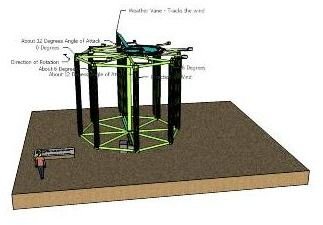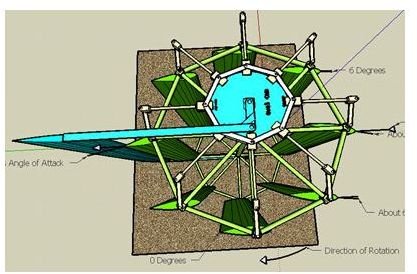What is Vertical Axis Windmill
Introduction
Harnessing renewable energy from the wind using windmills is an old but efficient method. Various changes in the design of a windmill have been made in order to improve the efficiency and power output. Though an old concept, a conventional windmill has often faced criticism for its unreliability. Its trait of utmost dependence on wind speed has been the sole reason for its fluctuating performance.
It is for this reason that a need to restyle the design of a conventional windmill keeping the basic principle same, has become a vital necessity. Once such effort has been made by a Toronto Designer Tom J. Gilmour who has conceptualised a windmill which rotates around a vertical axis instead of a conventional horizontal axis. The windmill is named Tom’s Whirligig. Let’s take a look at the design, construction and working of this innovative windmill which has changed the way of how a windmill looks and works.
Vertical Axis Windmill
Vertical axis windmill is a complicated but innovative design, probably the most complex for a wind power harnessing structure. Though the mechanism is not like that of any other conventional windmill, it works on the same principle of wind power generation.
The design of vertical windmill is based around a continuously rotating carousel, which comprises of symmetrical airfoils. The main feature of the windmill is that the whole system is mounted on a fixed vertical shaft. The vertical shaft remains stationary but airfoils can move 360 degrees, independent of the main shaft.
Working
Each airfoil can be rotated around its own axis with the help of a top mounted central weather vane. The central vane keeps the cam shaft pointed at the winds. In high intensity winds, the airfoils can be rotated to a zero angle of attack in order to prevent any kind of damage.
The main central fixed shaft is heavy and can withstand any possible wind load.
In order to make the structure lighter and less complex, the airfoils are attached to the carousel at the top and bottom. This gives the main spar of the airfoils extra freeness to rotate and also makes the overall structure lighter. The central weather vane and the cam moves extremely slowly and only with shifting wind direction.
All the forces experienced by the airfoil are transferred to the carousel through the airfoil’s mounting bearings. The push rod and bell cranks don’t perform much work. They just control the attitude of airfoils, close to their center of lift. The airfoils are so mounted that their point of rotation is forward of their center of lift. This will allow them to have a natural tendency to weather vane.

How many airfoils ?
Number of airfoils depends on the strength of the central shaft. A normal length windmill will comprise of eight airfoils but it can vary according to the requirement and design. The best efficiency can be achieved by keeping airfoils in multiples of 4,8,16 etc. This is because a system with only 2 airfoils would’t start by itself and the one having only 3 airfoils would’t be well balanced and stable.
References
Alternative energy news website
Image credits
